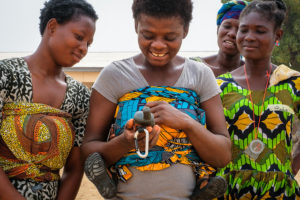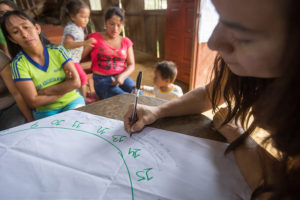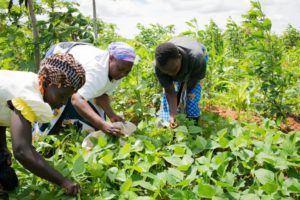
UN Women’s 2018 flagship report on gender and the Sustainable Development Goals (SDGs) offers a framework to monitor each of the 17 SDGs from a gender perspective, and takes stock of their performance to date.
The report calls for greater collaboration between researchers, governments and women’s organizations to realize the 2030 Agenda on Sustainable Development.
Bimbika Sijapati Basnett, gender coordinator for the Center for International Forestry Research (CIFOR) and CGIAR Research Program on Forests, Trees and Agroforestry (FTA) gender scientist, recently published a brief evaluating the report.
In this second installment of a two-part series, she analyzes the report and its implications for the CGIAR gender research community, reflecting upon entry points for CGIAR to respond to this call.
According to Antonio Guterres, Secretary-General of the United Nations, gender specific Sustainable Development Goal (SDG) number 5, and the mainstreaming of gender across the 17 other goals, is evidence that: “gender equality is a goal in its own right and a powerful force for upholding the main promise of the 2030 Agenda: to leave no one behind” (UN Women 2018, 2).
However, in its newly released flagship report monitoring each SDG from a gender and social inclusion perspective, UN Women finds that only six out of the 17 goals are gender sensitive (SDGs 1, 3, 4, 5, 8 and 16); five goals are gender sparse (SDGs 2, 19, 11, 13 and 17) and the remaining six are gender blind (SDGs 6, 7, 9, 12, 14 and 15). The available gender data presents gaps. There is inadequate investment and funding for additional or quality data collection. Data collection methodologies (e.g. censuses, labor surveys) present deep biases which prevent them from collecting reliable, gender disaggregated data.
Read more: What’s in it for gender researchers when it comes to UN Women’s gender and SDGs report?
According to the report, such monitoring is essential to: translate global commitments to results; offer space for public debate and democratic decision-making; determine each stakeholder’s (governments, citizens, civil society organizations, private sector) roles and responsibilities and strengthen accountability for actions or omissions (UN Women 2018, 24-25).
As a reminder, UN Women calls for greater and concerted effort among governments, researchers and women’s rights organizations to realize the 2030 Agenda on Sustainable Development. How so? By tracking progress against the goals, identifying achievements and gaps, and highlighting implementation challenges and opportunities.
As a global collective focusing on agriculture and natural resource management research in multiple countries and contexts across Africa, Asia and Latin America, the CGIAR gender research community is uniquely positioned to contribute to such endeavors.
In this blog, I reflect upon how the CGIAR gender research community can contribute more significantly towards future global efforts to monitor the SDGs from a gender and social inclusion perspective. This is the second part of a two-tier blog, the first of which unpacks the report and highlights its strengths and limitations.
Read more: UN Women’s evaluation of gender in the SDGs – What’s the role for the CGIAR?

Limited contribution of CGIAR gender researchers and research publications
The UN Women report does not significantly showcase CGIAR gender researchers and research publications. This is remarkable, considering the impressive number of academics, practitioners and policy makers, both within and outside the United Nations system, who have played a role as team members in writing the report, background paper authors, advisory members and reviewers. The report also features a comprehensive reference list combining both foundational and recent publications.
A quick search through the report returned only one CGIAR gender researcher (Sophia Huyer), acknowledged for her contribution as a report reviewer. Prominent CGIAR gender researchers are scarcely referenced: Cheryl Doss is referenced twice; Agnes Quisumbing once; Carol Colfer, Cynthia McDougall, Lone Badstue, Anne Larson, Esther Mwangi, Margreet Zwarteveen and Paula Kantor receive no mention. All of these authors are among CGIAR gender researchers who have contributed high quality publications on topics that are relevant to SDGs from a gender perspective – i.e. poverty, food security, inequality, land and water.
That said, direct participation of researchers and/or citation of their work may not be an effective way of measuring CGIAR research’s influence. Although Ruth Meinzen-Dick is not directly cited in the report, one of her well-recognized arguments that women’s land rights must be measured in terms of a ‘bundle of rights’[1], Meizen-Dick et al. 2014; Meizen-Dick et al. 2018; Ribot and Peluso 2003) is included, under the sub-section on ‘Spotlight on women’s equal rights to land’ (111).
As a gender researcher from CIFOR, working on FTA, I was particularly drawn to the report’s coverage on SDG 15 – ‘Life on Land’. One of CIFOR and FTA’s flagship publications on the gender dimensions of palm oil expansion in West Kalimantan, Indonesia (Li 2014, 2018) is featured as Case Study Box 3.3. This publication also contributes to the report’s broader argument that SDG implementation cannot be left to the private sector, and that governments need to drive the agenda, with civil society organizations supporting these efforts and holding government representatives to account.
However, the CIFOR study is (mis)presented in a way that pits local women against men. The report wrongly suggests that the deforestation and dispossession resulting from palm oil expansion in West Kalimantan have harmed local women and benefitted local men. The differentiated effects of palm oil expansion on diverse categories of women (painstakingly documented in the CIFOR publication) are not mentioned at all. This is unfortunate, given that Chapter 3 (‘Moving beyond averages’) examines the intersection between gender and other social difference axes in order to get to the roots of marginalization.
Suggestions and future: ‘strategic entry points’ and ‘getting house in order’
The CGIAR gender community could intervene in various areas.
CGIAR research can be leveraged to monitor against multiple SDGs. CGIAR research programs indeed focus on climate action (SDG 13), water (SDG 6), land and forests (SDG 15), fisheries (SDG 11) and energy (SDG 7). And all CGIAR research programs share Poverty (SDG 1), food security (SDGs 2 and 3), inequalities (SDG 10), employment and livelihoods (SDG 8) as cross-cutting concerns.
Guidance notes and training products developed by CGIAR gender researchers can be used to transform existing data collection methods to better capture lived realities of women. This could include the CGIAR Research Program on Policies, Institutions and Markets’ ‘Standards for collecting sex-disaggregated data’ (Doss and Kieran 2014); FTA’s ‘Practical tips for conducting gender responsive data collection’ (Elias et al. 2014); and the CGIAR Research Program on Aquatic Agricultural Systems’ publications on measuring gender transformative change (Hillenbrand et al. 2015).

Innovative, cross-CGIAR research methodologies (such as the Women’s Empowerment in Agriculture Index (WEAI) and GENNOVATE) and their research results can complement the data presented.
Emerging research on intersectionality can help better target policies and efforts.
Current data collection and collation initiatives (including through the CGIAR Platform for Big Data in Agriculture) may help identify broader patterns of gender inequalities and reform opportunities.
CGIAR gender researchers could play a role in generating synergies between SDGs and other global initiatives, such as Nationally Determined Contributions (NDCs), the Convention on the Elimination of all forms of Discrimination Against Women (CEDAW), the Convention on the Rights of the Child (CRC), the Convention on Biological Diversity (CBD) among others.
CGIAR gender researchers may also consider different ways of working so as to play a more prominent role in the 2030 Agenda, for example through:
- Actively seizing opportunities to inform future reports, including through a Memorandum of Understanding with the UN Women team that produces such reports;
- Capitalizing on relationships with governmental agencies, national statistics offices, and women’s organizations in the countries where we operate, so that we are routinely consulted on national efforts to monitor the SDGs;
- Demonstrating how our current research contributes to the SDGs, through mapping if, to what extent, and how CGIAR gender research contributes to each of the SDGs;
- Going beyond binary analyses of ‘women versus men’ to also account for differences within groups of women and men — and broadening our gaze to consider disabilities, sexuality and masculinities in CGIAR gender research;
- Moving beyond the confines of our specific sectors (agriculture, forestry, water) or commodities (rice, maize etc.) to inform cross-sectoral and national/regional/global efforts;
- Consolidating and harmonizing our research, research methodologies and findings to have a bigger voice and effect.
In summary, the CGIAR community is uniquely situated to respond to UN Women’s request for greater collaboration among researchers, governments and women’s organizations to realize the 2030 Agenda on Sustainable Development. As our first step in that direction, the CGIAR community could prioritize CGIAR-wide deliberations as to if and how they could play a more meaningful role. This blog contribution offers some ‘food for thought’ for embarking on such a deliberation.
By Bimbika Sijapati Basnett, originally published by the CGIAR Collaborative Platform for Gender Research.
[1] comprising documented ownership, ability/right to sell land and ability/right to bequeath land to others.











